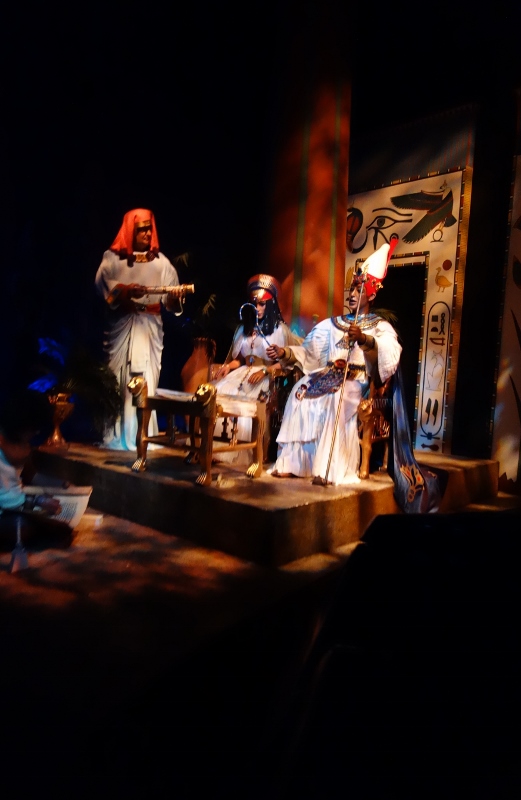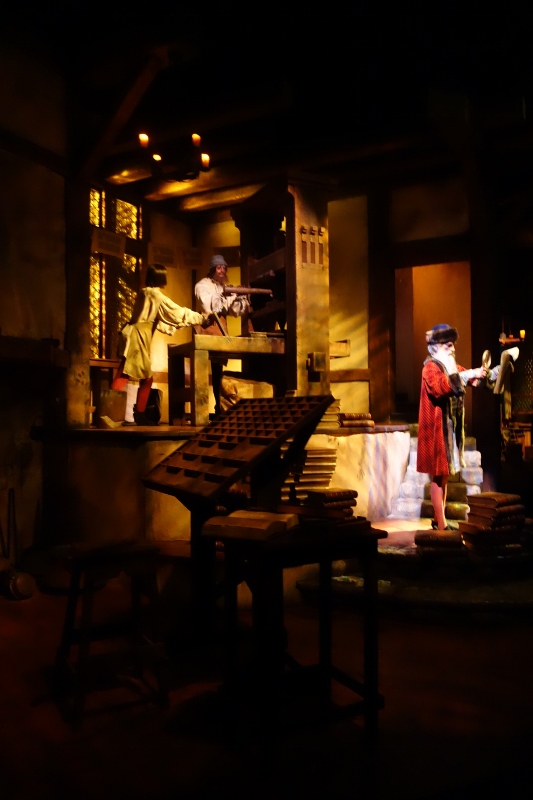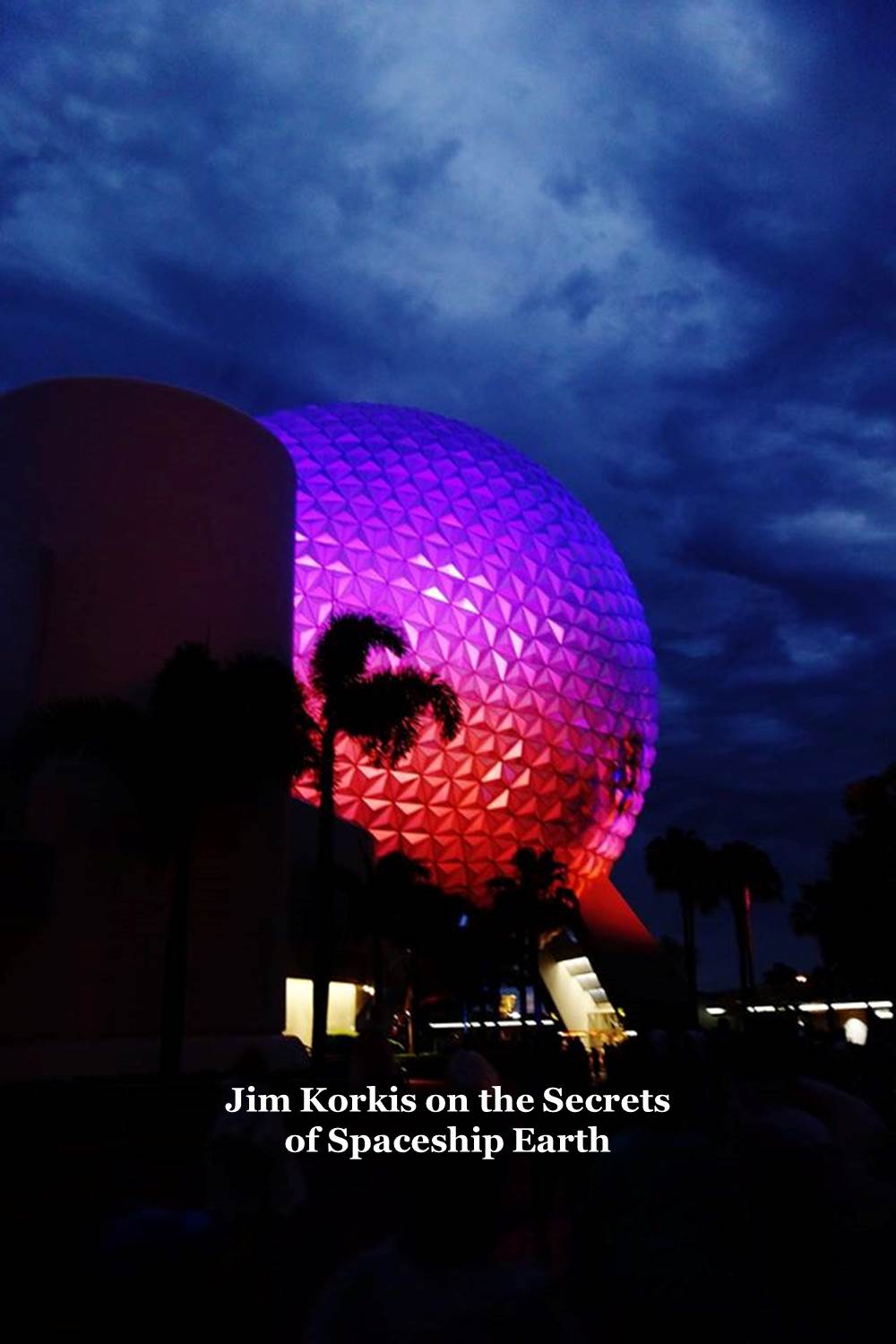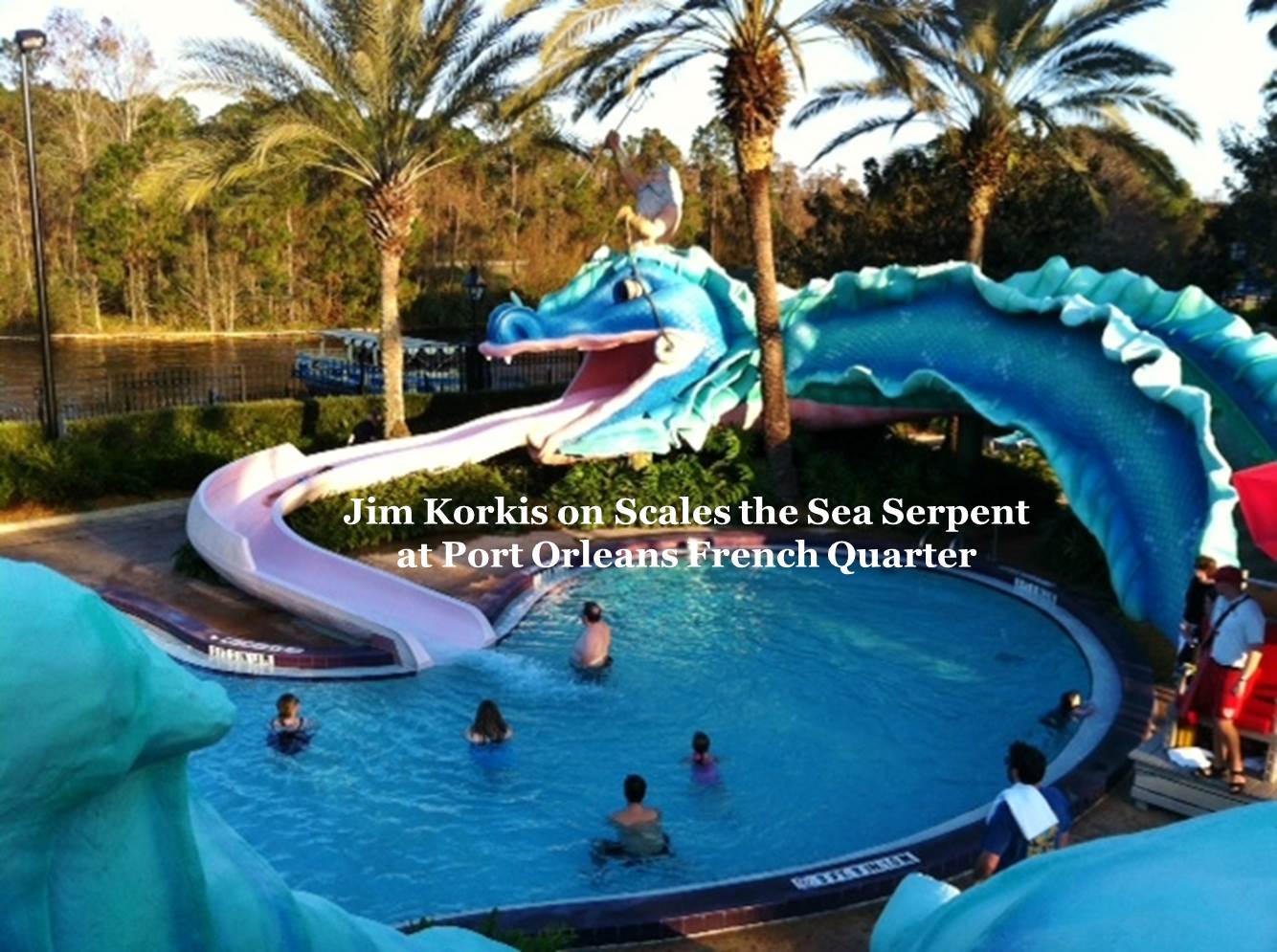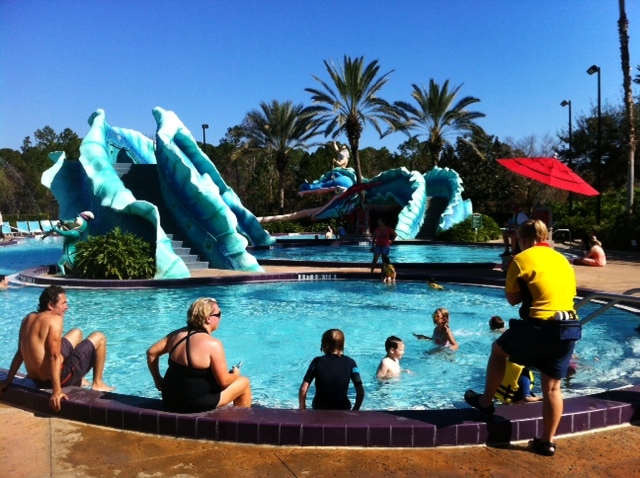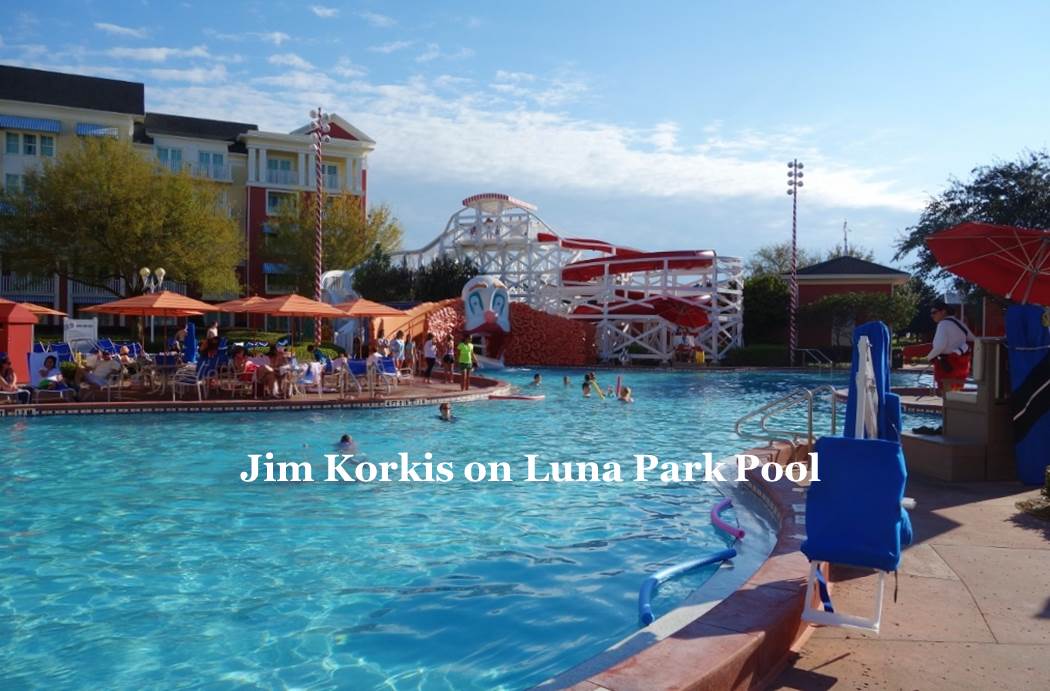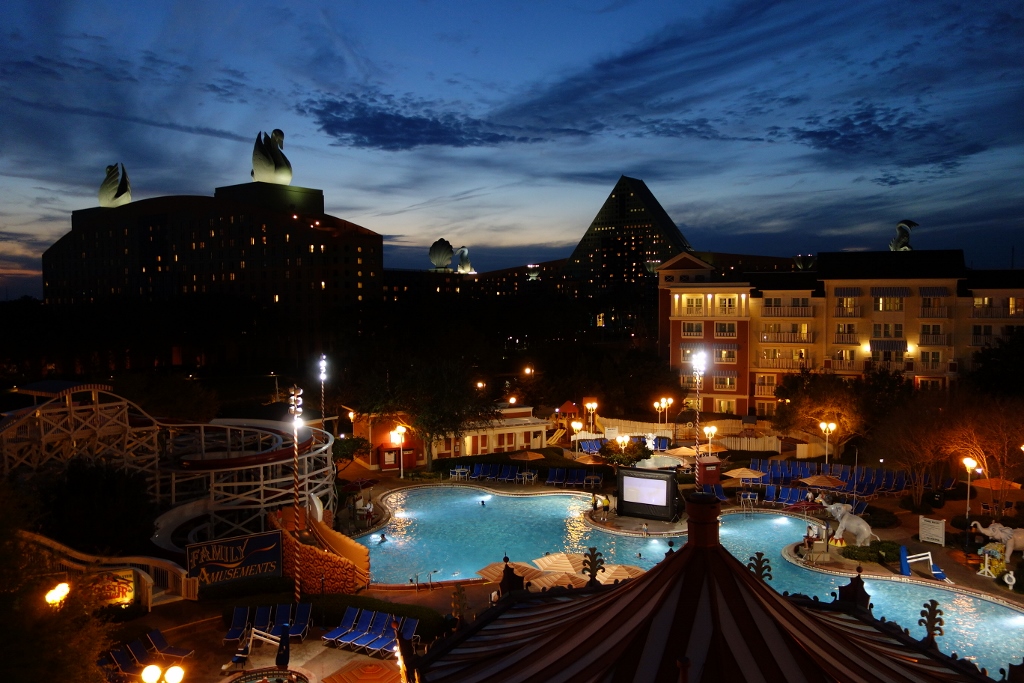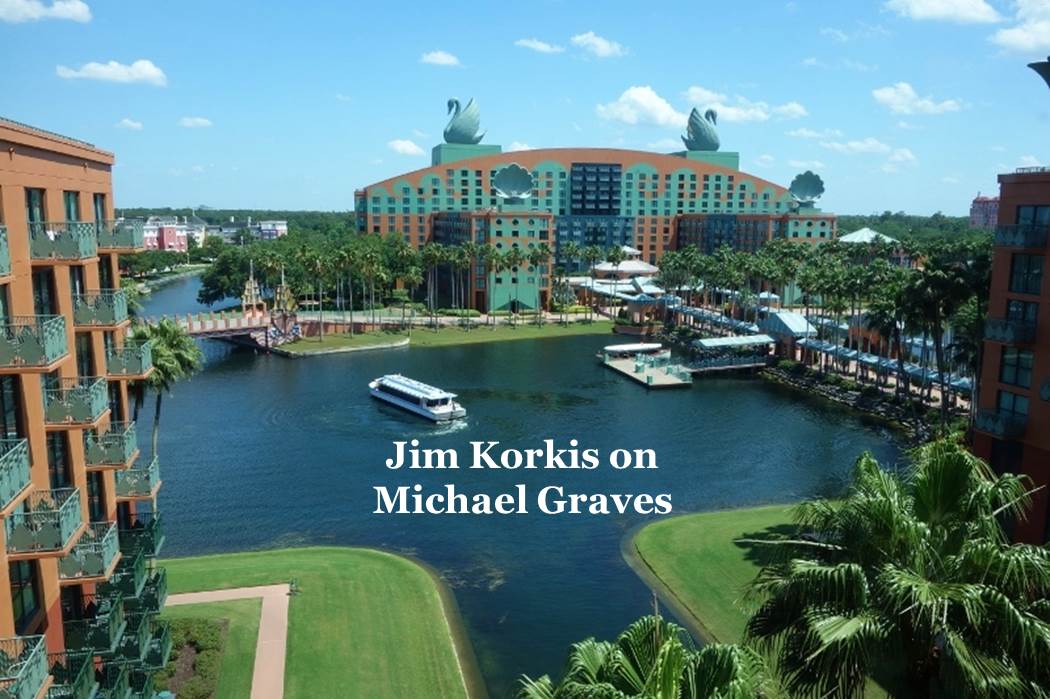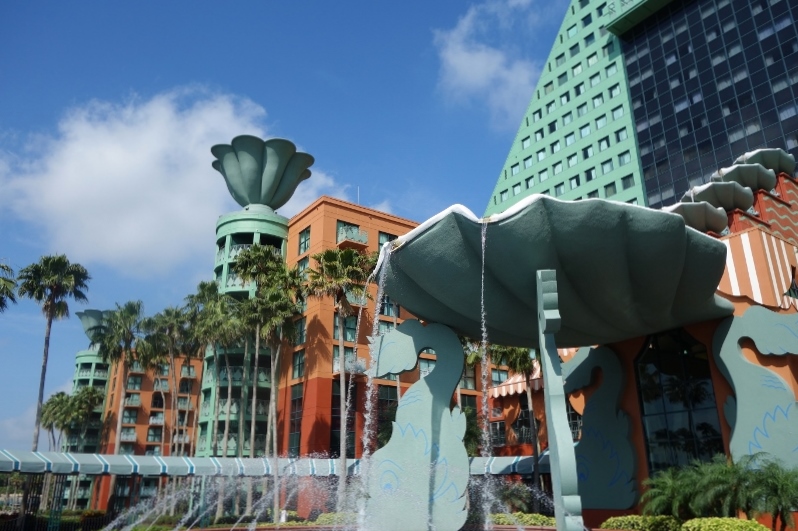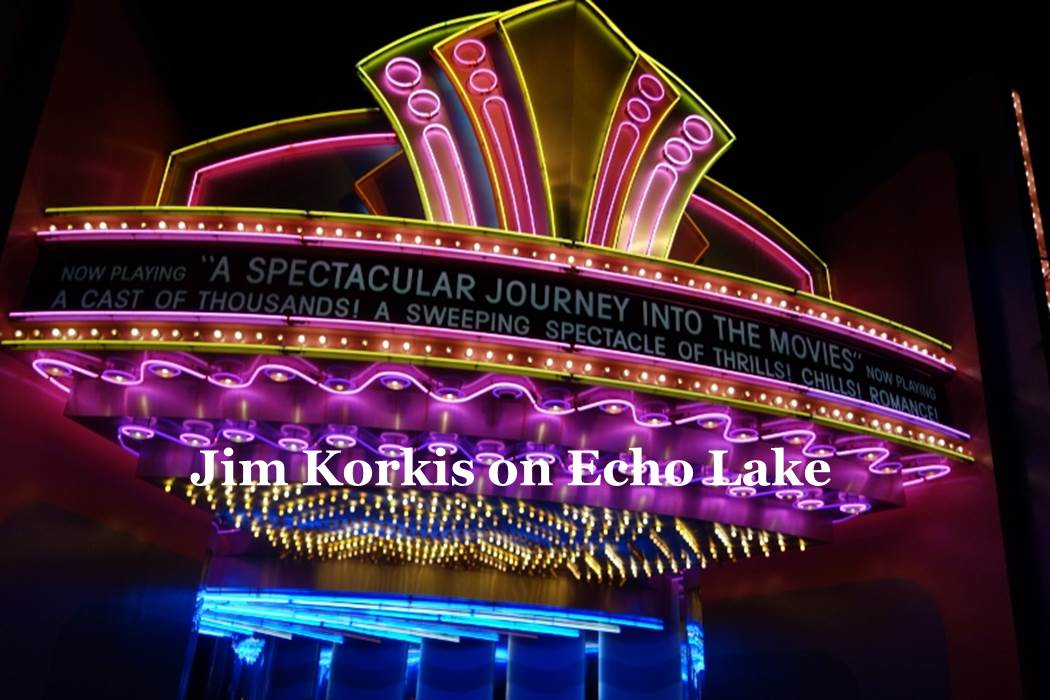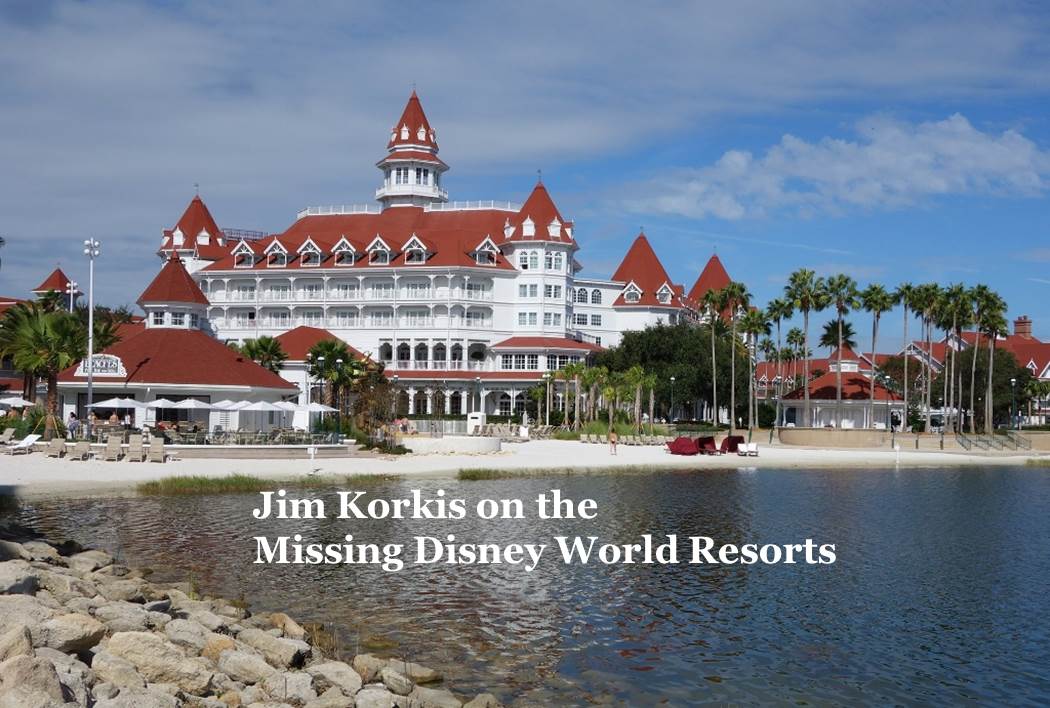Category — A Friday Visit with Jim Korkis
A Friday Visit With Jim Korkis: The Secrets of Spaceship Earth
Welcome back to Fridays with Jim Korkis! Jim, the dean of Disney historians and author of Jim’s Gems in The easy Guide, writes about Walt Disney World history every Friday on yourfirstvisit.net.
THE SECRETS OF SPACESHIP EARTH

Spaceship Earth at Epcot was not meant to be a museum, but even so, many of the props and inscriptions are authentic reproductions of the originals.
Imagineer John Hench insisted that the props in the attraction should be the closest approximation that could be created, even though few guests would be knowledgeable enough to know the difference.
Here are a handful of examples to look for on visits to the attraction.
Cro-Magnon Scene: The animal skulls in this scene include a saber-toothed tiger, a lion, a cave bear and two dire wolves. They were cast from molds of actual animals in the Paleolithic collection of the Page Museum in Los Angeles.
Egyptian Scene: The hieroglyphics are accurate and the gods Anubis, Soker, and Thoth are all represented. The translations of the hieroglyphics takes up several pages but are all authentic to the time period.
Roman Scene: The Latin inscription which appears at the entrance to the Roman scene comes from the first of The Twelve Tables of Roman Law that were codified about 451 B.C. and were regarded by later Romans as the foundation of all their laws. The laws were originally written on bronze tablets and placed in the marketplace for all to see and discuss.
The statue in the Roman scene is Augustus. The graffiti which appears on the walls in the “Fall of Rome” also appeared on the walls of ancient Pompeii and was taken from a collection of graffiti entitled “Loves and Lovers of Ancient Pompeii” by Professor Matteo Della Corte.
One example is “Quisquis amat pereat” that translates to “May whoever loves perish!”
Islamic Scene: The astronomer on the balcony holds a quadrant reproduced from photos of a 10th century Islamic quadrant supplied by the Metropolitan Museum of Art.
Medieval Scene: Mary Robertson, the Curator of Rare Manuscripts of the Huntington Library in San Marino, California, was consulted regarding creation of manuscripts during the Middle Ages.
Gutenberg Scene: Carey Bliss, the Curator of Rare Books of the Huntington Library in San Marino, California, was consulted regarding the printing of the Gutenberg Bible. In the Spaceship Earth scene, the page Herr Gutenberg is examining was recreated from a page from the actual original Gutenberg Bible in the Huntington Library collection.
Renaissance Music: Experts in the field of Renaissance musicology like Genette Foster from Occidental College in Los Angeles were engaged to consult and perform the music in this scene. The male musician is shown playing the lute and the female musician is playing the lira da braccio.
Steam Press/Newspaper Scene: The steam press which dominates the newspaper scene was designed from the actual patent drawings filed by William Bullock in 1863. The newspaper is a reproduction of the “New York Daily”.
Telegraph Scene: The calendar in the telegraph scene is a copy of a calendar from 1867 by Hatch and Co. Lithographers supplied by the Smithsonian Institution, from the collection of Business Americana.
Telephone Scene: The magneto switchboard was fabricated from an actual model circa 1898, supplied by AT&T.
This is just a quick glimpse into the many layers of authentic detail that the Disney Imagineers painstakingly added to this attraction. There are many more secrets waiting to be shared.
* * * * *
Thanks, Jim. Come back next Friday for more from Jim Korkis!
In the meantime, check out his books, including The Vault of Walt, Who’s Afraid of the Song of the South?, and The Book of Mouse
, and his contributions to The easy Guide to Your First Walt Disney World Visit, all published by Theme Park Press.
MORE DISNEY WORLD HISTORY POSTS FROM JIM KORKIS
- “Summer Magic” on Main Street
- Muppets and Mama Melrose
- Peter Dominick and the Wilderness Lodge
- Dixie Landing and Port Orleans Riverside
- The History of Splash Mountain
- The First Disney World Hotel
- The “Sharing the Magic” Statue
- The First Disney World Monorails
- The Water Park River Country
- The Epcot Fountain
- The Fireplace at the Wilderness Lodge
- Sid Cahuenga at Disney’s Hollywood Studios
- Spaceship Earth
- Downtown Disney
- The Missing Resorts
- Echo Park Homages
- Typhoon Lagoon
Follow yourfirstvisit.net on Facebook or Google+ or Twitter or Pinterest!!
July 31, 2015 No Comments
A Friday Visit With Jim Korkis: Scales the Sea Serpent at Port Orleans French Quarter
Welcome back to Fridays with Jim Korkis! Jim, the dean of Disney historians and author of Jim’s Gems in The easy Guide, writes about Walt Disney World history every Friday on yourfirstvisit.net.
SCALES AT PORT ORLEANS FRENCH QUARTER
By Jim Korkis

“Evoking a bygone era of romance and charm, the hidden courtyards, splashing fountains and lush gardens of Disney’s Port Orleans Resort create a welcome retreat. At the heart of it all is Doubloon Lagoon, where ‘Scales’ the sea serpent invites visitors to make a splash!”
Scales was an original Disney character created for the resort. His name was coined by Disney executive Greg Ehrbar, who was working for Disney marketing.
Contrary to popular belief, the sea serpent’s name was not originally meant to be a direct reference to the fact that he had scales on him like a dragon or a fish.
Rather, it was created by Ehrbar, a long time Disney fan and a well known authority on Disney music, with two books on the subject to his credit.
Port Orleans French Quarter once had a full-service restaurant called Bonfamille’s Café (closed last decade), and next to it was a bar, Scat Cat’s Club.
Disney animation fans will instantly remember that retired opera singer Madame Bonfamille was the owner of the talented French cats in the animated feature The Aristocats (1970).
Those famous felines were assisted in their adventures by a jazz band of cats led by their outrageous leader, Scat Cat.
There was a special children’s menu created for Bonfamille’s Café done in the form of a coloring booklet. It was written by Ehrbar and illustrated by the very talented Peter Emslie.
In the form of a photo album journal by Madame Adelaide Bonfamille, the booklet described how the good Madame, Duchess, the kittens, Thomas O’Malley and the Alley Cat Band took a musical cruise from Paris to Port Orleans, where they were “tailed” (followed) by a jazz-loving sea serpent.
The sea creature fell in love with the jazz that Scat Cat and his band played during the voyage. He was named “Scales”, a nod to musical scales and the Sherman Brothers tune from the film, “Scales and Arpeggios”.
The story closes with Scales staying at the resort to enjoy the music played by the resident “jazz gators.”
That’s why the costumed alligator statues with musical instruments are walking down the path to the pool. Just like pied pipers, they lead Scales to the pool just as they do guests today.
When the resort first opened, guests received a copy of the “Sassagoula Sentinel,” a faux newspaper that included guest information along with a fictional backstory for the resort.
While Disney Imagineers loved the name that Ehrbar had come up with for the sea serpent, they decided they wanted a story that was more in tune with the rest of the backstory they had created.
In their version, in order to frighten their children from exploring the swampy marshes and the dangers like alligators and snakes, the first settlers came up with the legend of a large serpentine creature that lurks beneath the surface of the still waters waiting to gobble up unsuspecting children.
When some of the older children did not believe the myth, a group of fathers decided to teach them a lesson and constructed a large dragon-like serpent out of fence wire and bed sheets to scare them.
Over the years, the serpent became a fixture of the Mardi Gras parades and was honored with his own water slide in the lagoon.
Whichever version of the story you chose to believe, it is just another example of how Walt Disney World resorts are filled with hidden storytelling treasures.
* * * * *
Thanks, Jim. For more from Jim on the history of the Port Orleans resorts, see this. And come back next Friday for more from Jim Korkis!
In the meantime, check out his books, including The Vault of Walt, Who’s Afraid of the Song of the South?, and The Book of Mouse
, and his contributions to The easy Guide to Your First Walt Disney World Visit, all published by Theme Park Press.
MORE DISNEY WORLD HISTORY POSTS FROM JIM KORKIS
- “Summer Magic” on Main Street
- Muppets and Mama Melrose
- Peter Dominick and the Wilderness Lodge
- Dixie Landing and Port Orleans Riverside
- The History of Splash Mountain
- The First Disney World Hotel
- The “Sharing the Magic” Statue
- The First Disney World Monorails
- The Water Park River Country
- The Epcot Fountain
- The Fireplace at the Wilderness Lodge
- Sid Cahuenga at Disney’s Hollywood Studios
- Spaceship Earth
- Downtown Disney
- The Missing Resorts
- Echo Park Homages
- Typhoon Lagoon
Follow yourfirstvisit.net on Facebook or Google+ or Twitter or Pinterest!!
July 24, 2015 1 Comment
A Friday Visit With Jim Korkis: Luna Park Pool
Welcome back to Fridays with Jim Korkis! Jim, the dean of Disney historians and author of Jim’s Gems in The easy Guide, writes about Walt Disney World history every Friday on yourfirstvisit.net.
LUNA PARK POOL
By Jim Korkis

The main themed pool at Disney’s BoardWalk Inn and Villas, Luna Park Pool, is a reference to one of the most popular early amusement parks at Coney Island.
Coney Island’s Luna Park was built and operated by Frederic Thompson and Elmer “Skip” Dundy from 1903 to 1944.
It was one of three major entertainment parks at Coney Island –the other two were Steeplechase Park and Dreamland.
That’s the reason why the proprietor of the “On the Boardwalk Thimbles & Threads” shop is “F. Thompson” and inside the resort’s main lobby you’ll find “Dundy’s Sundries—Serving the Boadwalk since 1902”.
It is 1902 because Thompson and Dundy’s amazing ride from the 1901 Pan-American Exposition (the World’s Fair held in New York) called “A Trip To The Moon” was moved to Coney Island’s Steeplechase Park for the 1902 season.
It was an electrically powered dark ride where thirty passengers boarded a wooden spacecraft and were taken on a visit to the moon complete with little people dressed up as moonmen. It proved so popular that Thompson and Dundy had enough money to build their own amusement venue, Luna Park.
“Luna” is Latin for the “moon” (and also the name of the airship vehicle in their attraction). Dundy’s sister was also named “Luna”.
Why are there elephants at the pool?
One of the biggest attractions at Coney Island’s Luna Park was its private herd of elephants, which roamed freely. Elephant rides were popular for the guests as well as a once-in-a-lifetime experience.
However, cleaning an elephant is a long, arduous task so it was quickly discovered that taking the elephants out to the Atlantic Ocean to bathe was not only easier but it was free publicity for the park.
The Keister Coaster pool slide is meant to be reminiscent of the many classic wooden roller coasters at Coney Island in its prime. That’s why it is a seemingly wooden structure.
However, the huge clown face at the end is not just to reference the many clowns at Coney Island, one of whom was the famous animation director Dave Fleischer, who was rotoscoped in his clown outfit to become KoKo the Clown, the famous silent animated cartoon character.
One of the popular Midway games was the Clown Water Gun Balloon Game where a patron would shoot water into the open mouth of the head of a clown to build up pressure to blow up the balloon on the head to pop first so the player could win against other competitors doing the exact same thing with other clown heads.
The game still exists today and is popular. A variation of the game, an auto race, is one of the Midway games in the Wildwood Landing section on Disney’s boardwalk.
The nearby Ferris W. Eahlers Community Hall is not an obscure reference to a turn-of-the-century personality or an Imagineer. Said aloud it sounds like “Ferris Wheelers”, a reference to the Coney Island ferris wheels.
While most guests are unfamiliar with these connections, for those few who are it enhances an already premium experience at the BoardWalk In n and Villas.
* * * * *
Thanks, Jim. Come back next Friday for more from Jim Korkis!
In the meantime, check out his books, including The Vault of Walt, Who’s Afraid of the Song of the South?, and The Book of Mouse
, and his contributions to The easy Guide to Your First Walt Disney World Visit, all published by Theme Park Press.
MORE DISNEY WORLD HISTORY POSTS FROM JIM KORKIS
- “Summer Magic” on Main Street
- Muppets and Mama Melrose
- Peter Dominick and the Wilderness Lodge
- Dixie Landing and Port Orleans Riverside
- The History of Splash Mountain
- The First Disney World Hotel
- The “Sharing the Magic” Statue
- The First Disney World Monorails
- The Water Park River Country
- The Epcot Fountain
- The Fireplace at the Wilderness Lodge
- Sid Cahuenga at Disney’s Hollywood Studios
- Spaceship Earth
- Downtown Disney
- The Missing Resorts
- Echo Park Homages
- Typhoon Lagoon
Follow yourfirstvisit.net on Facebook or Google+ or Twitter or Pinterest!!
July 17, 2015 No Comments
A Friday Visit With Jim Korkis: Architect Michael Graves
Welcome back to Fridays with Jim Korkis! Jim, the dean of Disney historians and author of Jim’s Gems in The easy Guide, writes about Walt Disney World history every Friday on yourfirstvisit.net.
DISNEY ARCHITECT MICHAEL GRAVES
By Jim Korkis

CEO Michael Eisner once claimed that the two legacies he would leave for Disney theme parks were improved culinary offerings and “entertainment architecture”—the idea that “even the architecture should entertain guests of all ages.”
The first architect that Eisner engaged to produce entertainment architecture was Michael Graves.
The Disney Company had always wanted the Walt Disney World property to be a vacation destination where guests would spend more than just a day or two at the theme park.
So, the company developed other options including water activities from skiing to boating, horseback riding, golf and more. In order to house the guests coming to enjoy these opportunities, the company built three resorts for Disney World’s opening, with plans to immediately build three more, but those plans were delayed by financial factors.
By the time Michael Eisner became Chairman and CEO of the Disney Company in 1984, the company’s connection to innovative themed resorts had faded although the number of guests coming to WDW had greatly increased.
Eisner rejected a plan to build two rather ordinary hotel towers (that he referred to as “refrigerator boxes”) near Epcot.
At this time, Eisner even suggested building a hotel in the shape of Mickey Mouse that would straddle Lake Buena Vista Drive with elevators going up each of Mickey’s legs and cars driving underneath the icon’s crotch.
After some legal wrangling with the Tishman Corporation, Eisner hired the award-winning Princeton architect Michael Graves—who had never designed a hotel before—to design the Walt Disney Swan and Dolphin hotels.
The hotels were intended to accommodate the convention groups who were staying at off-property hotels that had greater convention space than the existing Disney World resorts. When the Swan and Dolphin opened in 1989 and 1990, they offered the largest hotel convention space in the Southeastern United States.
Over the years, the look of the hotels have been the source of much discussion (not all of it flattering). That was intentional, to bring attention to what Eisner described as Disney’s “entertainment architecture” of unusual buildings done by noted architects.
Architect Michael Graves is often described as putting the concept of architectural postmodernism on the map.
His works range from large projects such as buildings to whimsical designs for furniture, teapots, and other household items.
In March 1997, Graves was working on the post office for the city of Celebration that he described as the “smallest building in the city” and was amused that he was responsible for the smallest building and the largest building (The Dolphin hotel) currently on Walt Disney World property.
For his first architectural assignment for the Disney Company, Graves had designed the Team Disney corporate building in Burbank, California.
Graves said when he was in meetings with Michael Eisner, Michael told him: “Look, everyone here will have some design priorities for you but I only have one priority. When I come in to work each morning and go up to my office, I’ll probably have very little to smile about. So do something that will make me smile when I arrive.”
When his first designs for the Team Disney building were rejected, Graves came up with the concept of having the Seven Dwarfs as caryatids. A caryatid is a sculpted figure serving as an architectural support taking the place of a column or a pillar supporting horizontal bands.
This design was “because Snow White and the Seven Dwarfs was truly the foundation of the Disney Studios, and supported the growth of the company just as the dwarfs are supporting the building,” claimed Graves.
* * * * *
Thanks, Jim. Frankly, I find the Swan and Dolphin odd-looking. But I do indeed notice them. I stayed at the Swan in April and the Dolphin in May, and will shortly be publishing updated reviews.
Come back next Friday for more from Jim Korkis!
In the meantime, check out his books, including The Vault of Walt, Who’s Afraid of the Song of the South?, and The Book of Mouse
, and his contributions to The easy Guide to Your First Walt Disney World Visit, all published by Theme Park Press.
MORE DISNEY WORLD HISTORY POSTS FROM JIM KORKIS
- “Summer Magic” on Main Street
- Muppets and Mama Melrose
- Peter Dominick and the Wilderness Lodge
- Dixie Landing and Port Orleans Riverside
- The History of Splash Mountain
- The First Disney World Hotel
- The “Sharing the Magic” Statue
- The First Disney World Monorails
- The Water Park River Country
- The Epcot Fountain
- The Fireplace at the Wilderness Lodge
- Sid Cahuenga at Disney’s Hollywood Studios
- Spaceship Earth
- Downtown Disney
- The Missing Resorts
- Echo Park Homages
- Typhoon Lagoon
Follow yourfirstvisit.net on Facebook or Google+ or Twitter or Pinterest!!
July 10, 2015 4 Comments
A Friday Visit With Jim Korkis: Echo Park Homages
Welcome back to Fridays with Jim Korkis! Jim, the dean of Disney historians and author of Jim’s Gems in The easy Guide, writes about Walt Disney World history every Friday on yourfirstvisit.net.
HOMAGES TO ECHO PARK

On the first 1989 guide maps, the area that today is known as “Echo Lake” at what was then called Disney MGM Studios was referred to as “Lakeside Circle.”
However, even then this area of what became Disney’s Hollywood Studios was meant to be an homage to the real Echo Park that was built and opened in Los Angeles in 1895. Hence the name change to Echo Lake.
Before the development of Hollywood as the motion picture capital, most of the Los Angeles film industry was centered in a different place, the Echo Park area, including Mack Sennett’s Keystone Studios, which was located on Keystone Street (now part of Glendale Boulevard).
Sennett was known for his outstanding silent movie comedies, including those starring the frantic and inept Keystone Kops as well as Charlie Chaplin, and often used the Echo Park as the setting for some of those wacky comedies.
At today’s Disney’s Hollywood Studios, the Keystone Clothiers building stands at the entranceway to the Echo Park area as a clever reference to that early filmmaker.
Just a few feet from the street sign that says “Keystone Street” is Peevy’s Polar Pipeline, featuring frozen Coca-Cola Concoctions, as well as regular soft drinks and assorted snacks.
When the park opened in 1989, this location was known as Lakeside News, a newsstand that sold a variety of magazines. The architectural inspiration for the façade of the building was a fire station on Pasadena Avenue in Lincoln Heights, built in 1940 but still in operation today.
The location was reformatted and named “Peevy’s” to reference the mechanic character from the Touchstone Pictures film “The Rocketeer” (1991). The film was set in 1938 Los Angeles so it fits in quite well with the park’s theme of Hollywood of the Thirties and Forties.
The location is filled with wonderful details including vintage welding tanks. A close examination of the menu will reveal that it is printed on faded blueprints for the famous Rocketeer rocket pack.
Sharp-eyed fans will also notice that to the left of the stand is an actual rocket pack used in the movie. Just above it is a helmet (actually a stunt helmet from the film because it is wider, making it easier for a stunt man to remove in the air during a dangerous maneuver).
To the right side is a door with the logo for the Holly-Vermont Realty Office. This was the location of Walt Disney’s first studio in Hollywood. When he signed the contract for the first Alice Comedies, he went to this office looking to rent an inexpensive space for the new Disney Brothers Studio.
The owners rented him a room in their building for ten dollars a month from October 1923 to February 1924, when Walt moved to a larger space next door on Kingswell Avenue. The sign in the upper window listing “Space for Rent” suggests that Walt has already moved out to bigger and better things.
The Art Deco restaurant Hollywood and Vine, the “Cafeteria to the Stars”, is modeled after a cafeteria that once stood at 1725 North Vine, near Hollywood Blvd. Before the dawn of fast food, these cafeterias provided actors (and Walt and Roy as well) with inexpensive and varied choices.
Along the inside wall of Hollywood and Vine is a beautiful 42 foot by 8 foot mural depicting some of the highlights of the Hollywood area, including the Disney Studios and the Carthay Circle Theater.
There are many more secrets and stories waiting to be discovered in this quiet and beautiful section of Disney Hollywood Studios for the curious Disney fan willing to spend some time reliving the Hollywood of the past.
* * * * *
Come back next Friday for more from Jim Korkis.
In the meantime, check out his books, including The Vault of Walt, Who’s Afraid of the Song of the South?, and The Book of Mouse
, and his contributions to The easy Guide to Your First Walt Disney World Visit, all published by Theme Park Press.
MORE DISNEY WORLD HISTORY POSTS FROM JIM KORKIS
- “Summer Magic” on Main Street
- Muppets and Mama Melrose
- Peter Dominick and the Wilderness Lodge
- Dixie Landing and Port Orleans Riverside
- The History of Splash Mountain
- The First Disney World Hotel
- The “Sharing the Magic” Statue
- The First Disney World Monorails
- The Water Park River Country
- The Epcot Fountain
- The Fireplace at the Wilderness Lodge
- Sid Cahuenga at Disney’s Hollywood Studios
- Spaceship Earth
- Downtown Disney
- The Missing Resorts
- Echo Park Homages
- Typhoon Lagoon
Follow yourfirstvisit.net on Facebook or Google+ or Twitter or Pinterest!!
June 26, 2015 No Comments
A Friday Visit With Jim Korkis: The Missing Disney World Resorts
Welcome back to Fridays with Jim Korkis! Jim, the dean of Disney historians and author of Jim’s Gems in The easy Guide, writes about Walt Disney World history every Friday on yourfirstvisit.net.
THE THREE MISSING DISNEY WORLD RESORTS
By Jim Korkis

“The hotels are called ‘theme resorts’ because everything from interior décor to employees’ costumes and dining room menus will carry out an overall theme. Two hotels, the Contemporary-style and the Polynesian, will open the first year. The Asian, Persian and Venetian will follow later in the Phase One plan.”
The Phase One plan for Walt Disney World was that not everything could be built and operational by October 1971, but rather was planned to be added in total within the first five years.
The Disney Company was very specific what the Asian, Persian and Venetian hotels would be like:
“The Asian hotel will be strongly Thai in its motif. A theme restaurant and lounge at the top of its 160 foot tower building will provide an enchanting setting for nighttime dancing and stage show entertainment. Each of its 600 rooms, including 50 elegant suites in royal Thai décor, will look out on the lagoon or a central recreation area.”
The Asian resort hotel was scheduled to open by 1973. Land had been cleared and prepared where Disney’s Grand Floridian Resort & Spa stands today.
A square plot of land prominently jutted out into the Seven Seas Lagoon and the nearby road had been dubbed “Asian Way”. There were also plans to have large meeting rooms under the guest area of the resort for conventions.
Design for the Asian resort went as far that a sample interior for the rooms was completed and approved, and elaborate Oriental gardens had been designed by landscaper Bill Evans. Guest rooms would have been arranged in a square around the perimeter, with two-thirds of the guest rooms having beautiful garden or lake views. The remainder of the rooms would have been in a tower building providing a view into the central recreation area that would probably have featured a themed pool.
“At the Venetian resort, an enclosed small boat harbor and intricate system of waterways will recreate the old world charm of the famed Italian ‘City of Canals’. Shopping will be a unique experience as guests travel by gondola along ‘streets of water’ and under ornate bridges linking various sections of the resort. The style is reminiscent of St. Mark’s Square, complete with a 120 foot campanile which will toll the time. The entire lobby will be glass-topped, creating a brilliant, sunlit atrium effect indoors.”
Intended to be located between the Contemporary Resort and the Ticket and Transportation Center on the Seven Seas Lagoon, the Venetian would have resembled the current Italian pavilion at the World Showcase at Epcot in terms of architecture and style.
“Stepping right out of The Arabian Nights is the Persian resort which will reign like an exotic far-Eastern palace on the Northwest shore of [Bay Lake]. Jewel-like mosques and columns will rise above landscaped courtyards, while terraced sundecks offer sculpted swimming pools and ‘old Persian’ dining facilities. Guests will practically be able to sail to their own rooms through a sheltered marina.”
Intended to be located to the north and slightly east of the Contemporary Resort on Bay Lake, the Persian would have been laid out in a circular pattern with a large central building featuring a twenty-four foot blue dome. Smaller blue domes would have highlighted the white columns and buildings.
After a stop at the Contemporary, the monorail would have journeyed to the Persian. From there, instead of the current route, the monorail would take a short detour through nearby Tomorrowland, just like the monorail at Disneyland, to offer park guests a glimpse of the highway in the sky in the future.
These unbuilt resorts were meant to create an exotic and unique experience for WDW guests from the seven seas of the world. That’s why it is the Seven Seas Lagoon.
* * * * *
Thanks, Jim! None of these were built–partly because of the 1973 oil crisis, and partly because attention (and capital) turned to Epcot. As Jim noted, the location planned for the Asian hotel was filled by the Grand Floridian in the late 80s.
Disney comes back now and then to the Venetian resort location, which would be on the monorail and is classed as a suitable site for development on Disney’s land-use plans. (Red circle on the map below, cut and pasted from this.)
However, apparently the soil characteristics make it very expensive to build there.
The site for the Persian, circled in gold, is now classed as “Marginally Suitable,” which is defined in the land use plans as areas where development “is strongly discouraged and would require mitigation of wetland impacts.”
Come back next Friday for more from Jim Korkis.
In the meantime, check out his books, including The Vault of Walt, Who’s Afraid of the Song of the South?, and The Book of Mouse
, and his contributions to The easy Guide to Your First Walt Disney World Visit, all published by Theme Park Press.
MORE DISNEY WORLD HISTORY POSTS FROM JIM KORKIS
- “Summer Magic” on Main Street
- Muppets and Mama Melrose
- Peter Dominick and the Wilderness Lodge
- Dixie Landing and Port Orleans Riverside
- The History of Splash Mountain
- The First Disney World Hotel
- The “Sharing the Magic” Statue
- The First Disney World Monorails
- The Water Park River Country
- The Epcot Fountain
- The Fireplace at the Wilderness Lodge
- Sid Cahuenga at Disney’s Hollywood Studios
- Spaceship Earth
- Downtown Disney
- The Missing Resorts
- Echo Park and Echo Lake
- Typhoon Lagoon
Follow yourfirstvisit.net on Facebook or Google+ or Twitter or Pinterest!!
June 19, 2015 2 Comments

